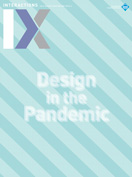Authors:
Alex Taylor, Daniela Rosner, Mikael Wiberg
The impact of Covid-19, worldwide, is still hard to absorb. We have no doubt that our contributors and readers are feeling, like us, overwhelmed. Many are likely to have been significantly affected—by furloughs and layoffs, or experiencing friends, loved ones, and family fall ill or pass away. At the same time, it's difficult to extricate oneself from the mundanity of everyday life, which may even be a relief and an escape for some. In the lockdowns to which so many have been subject, everything from domestic routines and food shopping to childcare and homeschooling have cast life anew. Simultaneously, these situations become a monotonous cycle of hard-to-distinguish days and weeks. The oscillations can make it feel like we are caught in a flux, slipping between catastrophic worldwide events and the minutiae of daily life.
And yet it's also abundantly clear that the challenges for many of us begin from a position of privilege. Individually, some of us may be facing immense and intensely painful hardships. Some of us may be fighting for justice for Black lives in a movement that has found heighted recognition across the globe. Amid the double pandemic of racism and the novel coronavirus, we see vividly how the structures that have enabled and sustained the world order—of society writ large—rely on longstanding and deeply routed practices of discrimination and exploitation. With the spread of coronavirus, we might be quick to think the virus itself has accentuated the gap between the haves and have nots. But, as is so often the case, the impulse to reduce and bifurcate causes in response to social crises belies a deeper complexity. Creating the conditions for these deadly inequities are histories strewn across colonial and post-colonial lines, enmeshed in global supply chains, and etched into flows of wealth, capital, and labor.
From the early days of the outbreak and under the shadow of these deep-seated social issues, interactive technology has made its mark. It has woven through and across the varied scales of life being impacted, so much so that many will have taken to new tools for remote meetings, for teaching and research, and for staying in touch with friends and family. The tensions between a social closeness, on the one hand, and a palpable sense of missing physical contact, on the other, are being felt acutely. Evocative too are the memories these technologies trigger of our own legacies in human-computer interaction and computer-supported collaborative work, of what might at the time have felt like a preoccupation with working from a distance. We have also seen calls for and corresponding concerns about tracking and contact tracing systems. The hardware and software for these systems strike a chord with those who have worked on pervasive and ubiquitous computing, dating back over 30 years. The echoes from the past will sound loudly for more than a few of our readers.
We had no real idea of what was to come, of course. But in those early weeks, as the coronavirus spread across our (temporarily) common geography in Europe, we as an editorial team felt a deep unease in carrying on with business as usual. Seeing the beginnings of the impact—nationwide lockdowns, shocking numbers of people being admitted to hospitals, terrible accounts of isolation and ill health—we felt an urgent call to respond to the situation. With the pressure to keep up a pretense of business as usual coming from so many quarters, we sought to slow down, to reflect, and to ask questions about what, exactly, design is invested in or committed to.
In discussion with the ACM, we thus decided to call on our community, sending an invitation far and wide, to share their immediate thoughts, reflections, and responses to the crisis. We opted to delay the publication of the print issue and instead go live with content promptly via our magazine's blog. We felt this would embody our aims of a design that is responsive and responsible. The pieces that people have so generously offered in response to our invitation cut across many of these critical issues. Authors have asked questions of how we should continue with our design work and scholarship in these times, how we should adjust and respond, and what might be more equitable ways of approaching design and building technologies.
This print issue captures a moment in contributors' efforts and reflections. Some have left their original blog posts unchanged, whereas others have amended and added to their thoughts, refining their ideas and, where possible, updating them in response to the crisis. To organize the contributions, we have separated the 27 articles into four sections: An Unusual Business, What We Knew Then... And What We Know Now, A Responsive Kind of Design, and Just Futures. While there are many common threads running through the texts, we felt these sections captured the different responses put forward by the mixture of makers, practitioners, and researchers in design. They represent the impulse of our community to support people, to continue taking on and sharing joint work, to respond to difficult and challenging conditions, and to consider how we might design more just and equitable futures.
Alex Taylor, Daniela Rosner, Mikael Wiberg [email protected]
Copyright held by authors
The Digital Library is published by the Association for Computing Machinery. Copyright © 2020 ACM, Inc.







Post Comment
No Comments Found